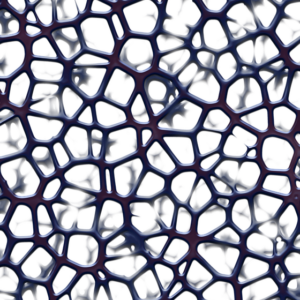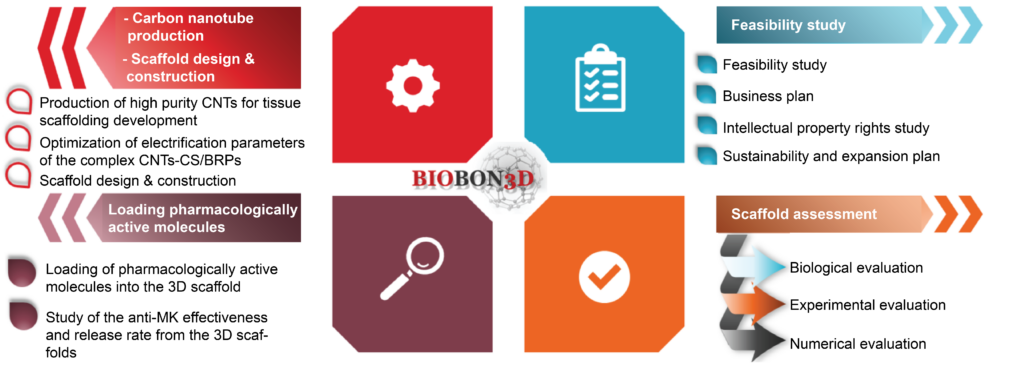BioBon3D
Biomimetic nanostructures 3D scaffolds for bone regeneration: Control of osteogenesis and angiogenesis through physicochemical stimuli
One of the biggest challenges in the construction of large tissue implants is the difficulty of developing permeable scaffolds for the transport of nutrients and waste, and spatial distribution of cells with high density and viability. Modern manufacturing techniques make it possible to reproduce the inherent structural features of tissues and to control the flow of nutrients to the scaffold by controlling parameters such as porosity, pore size and interconnection. Successful bone regeneration also requires sufficient rigidity for mechanical support and stability, and at the same time adequate flexibility for mechanical stimulation of cells.
BioBon3D inspires to develop hybrid nanocomposite scaffolds which, morphologically and structurally, will mimic the natural extracellular space.
Διάβασε Περισσότερα/ Read MoreMore specifically, three-dimensional (3D) scaffolds with appropriate structural characteristics (interconnected pores, hierarchically structured) and stiffness for the regeneration of bone defects will be developed. The scaffolds will be hybrids, consisting of natural polymers (e.g. chitosan (CS), due to their biocompatibility and antimicrobial activity) mixed with artificially biodegradable polymers (BRPs) to achieve suitably adapted properties and controlled biodiability. To enhance the composites, various types of Carbon Nanoparticles (NPCs), that have the ability to induce osteogenesis, will be used. The surface of the CNPs will be modified by the use of appropriate chemical processes, which will first lead to the improvement of their binding to the polymers and then to their better dispersion within the polymers.
Modern techniques, electrospinning and 3D printing, will be further developed to achieve the construction of 3D structures with appropriate pore size, structure and stiffness, smaller and comparable to that of spongy bone.
The scaffolds will be “loaded” with growth factors and antibodies that will be gradually released to induce osteogenesis and angiogenesis. The functionality of the new hybrid materials will be evaluated by analyzing their osteogenetic and angiogenic capacity in vitro and in vivo. For in-vitro biological evaluation, scaffolds fed precursor mesenchymal cells (hUCMSC) or hUCMSC in endothelial cell co-culture (HUVEC) will be cultured in a dynamic flow bioreactor with mechanical stimulus application. For the in-vivo biological evaluation, an experimental study will be performed in rodents and the filling time of the bone defects as well as the quality-strength of the newly formed bone will be evaluated comparatively.
Finally, numerical methods will be developed for the parametric study of mechanical and geometric characteristics and the simulation of cell proliferation, osteogenesis and angiogenesis, for the evaluation of the proposed scaffolds. The combination of experimental and numerical techniques will contribute to the validation of the experimental results and the production of new knowledge regarding the effect of structural changes of the scaffold that can not be observed with experimental techniques alone. In addition, modeling will help to reduce the number of experiments, which increase the cost and time for the project completion, during the further development phase of any products that will arise.
The project objectives are:
Objective 1
The development of functional biomimetic nanocomposite scaffolds with a structure that combines mechanical stiffness with the appropriate characteristics of porosity, to achieve the optimal environment for cell growth and differentiation.

Objective 2
The process of “loading” biological agents to achieve acceleration of the osteogenetic and angiogenetic process.

Objective 3
The comprehensive evaluation of the osteogenetic and angiogenic capacity of scaffolding, combining experimental in-vivo, in-vitro and computational techniques.

Goals and objectives of the BioBon3D Project

Methodological Implementation
Based on the progress made to date, BioBon3D inspires to manufacture nanocomposite 3D scaffolds, reinforced with CNP (CNTs or GNPs or GO), with the product innovation consisting of:
(a) Creation of third generation scaffolds that will be osteoinductive and have appropriate mechanical and structural characteristics.
(b) Development and introduction of modern electrofibrillation and 3D printing techniques for the creation of 3D nanocomposite scaffolds with controlled stiffness.
(c) New CS coupling techniques in CNPs, to achieve homogeneity in the dispersion of mixtures for the construction of scaffolding.
(d) “Loading” growth factors and antibodies on the scaffold and co-culture cells for osteogenesis and angiogenesis.
(e) Modeling of the scaffold structure and regenerative processes.
(f) Combination of experimental and numerical methods for its evaluation.

Διάβασε Περισσότερα/ Read More
Stage 1 – Manufacturing and characterization of 3D scaffolding:
A. High purity CNP modification: The CNPs used to reinforce the scaffolds will be high purity CNTs or GNPs or GOs, up to 98.5%. The first step in the chemical modification of CNPs involves the formation of carboxyl groups (-COOH), using acid oxidation protocols or combinations of acids (HNO3, HCl, H2SO4 and H2O2, piranha solution, basil water). Chitosan CNP chemical modification protocols (CNP-CS) will be developed and optimized. CNP-CS conjugates will be prepared based on successful protocols, which will be modified accordingly and optimized for CS binding of various molecular weights. Various dispersion mixtures of CNP-CS will be prepared in solutions of suitable BRPs such as e.g. PCL, PLA, PVA, in order to determine the most suitable CNP-CS / BRP mixture that will be used later for the construction of the 3D scaffold with the methods of electrofibrillation and 3D printing. All CNP-based materials to be produced will be characterized by the appropriate analytical methods including Scanning Electron Microscopy (SEM), Raman Spectroscopy, Thermogravimetric Analysis (TGA) and X-ray Diffusion Spectroscopy (EDX). Infrared (IR) spectroscopy.
B. Manufacture of 3D scaffolds by electrofibration / Production of composite nanofibers from CNP-CS / BRP: Initial combinations of electrofibrification parameters will be determined for each combination of polymer solutions (DC voltage), needle-collector distance (10-25 cm), volumetric flow rate of the solution) in order to achieve optimization of the scaffold characteristics in relation to the initial aspirations: the porosity will be sought to be as large as possible, so that the pores are interconnected, but the scaffolds have sufficient stiffness. To achieve a pore size of up to 300 μm, a properly structured steel mesh can be used as a special collector in the electrofibrillation. Randomly oriented fibers or parallel fibers will be created, which will be prepared with a properly rotating collector (dram) by adjusting its rotation frequency. The 3D scaffolds will be made by depositing different membranes and gluing one on top of the other (layer-by-layer assembly), or alternatively by wrapping membranes, at least 3-5 mm thick.
C. Manufacture of 3D scaffolding with 3D printing / Manufacture of nanomodulated polymer yarn: With 3D printing, scaffolds containing different percentages of CNP-CS will be prepared by the method of melt blending which is achieved by extrusion using the extruder Composer 450. The mixing of CNPs with polymers will be done mechanically, and carried out in slow turns and for a certain period of time in order to achieve an initial homogeneity in the mixture. Due to the same form of the individual components (powder) the mixture will be stable, homogeneous and can be introduced into the extruder. From the extrusion the material results in the form of a thread which is then cut into a pellet. The produced pellets will be fed back to the extruder at least once in order to improve the homogeneity of the nano-modified mixture. Depending on the type of original polymer(s) and CNPs, as well as their content, the number of feedbacks will vary and will be determined after quality control. The nano-modified yarn produced will be used as a 3D printer feedstock for the implementation of the next phase of scaffolding production.
3D printing: The scaffold will be designed with a suitable design program. The design of the scaffolding structure envisages a gradual increase in pores in height. The appropriate settings for printing the scaffold using the nano-modified yarn will be then selected. Printing will be done using the Edison AEP printer. The observation and control of the samples as well as the determination of the diameter of their pores will be carried out through optical microscopy and appropriate analysis software.
D. 3D scaffold characterization: Characterization includes the control of nano- and microstructure, mechanical properties and in vitro biodegradation. The microstructure will be determined by SEM / TEM microanalysis as well as by confocal microscopy. The morphology of the scaffolding surface at the micro / nano level, as well as their surface mechanical properties, will be determined by Atomic Force Microscopy in combination with the nanoindentation technique. The mechanical characteristics will be determined by mechanical tests in three-point compression and bending. In addition, a study of the thermo-mechanical properties of the materials will be carried out through Dynamic Mechanical Analysis (DMA). Finally, the thermal characteristics of the materials (melting point, etc.) will be studied through Differential Scanning Calorimetry (DSC). The biodegradation of the 3D polymers will take place in vitro in heat-controlled water baths at 37°C, normal pH and electrolyte concentrations. Mass loss over time as well as changes in structural integrity and mechanical behavior compared to the original specimens will be determined.
Stage 2 – Loading the 3D scaffolds with BMP-2, and / or VEGF-A and / or antibody to the MK protein:
Polymers (alginic acid or heparin or hyaluronic acid) containing different concentrations of anti-MK will be incorporated between the different 2D membranes of the electrofibrated scaffolds, so that slow and sustained release of the antibody is achieved. When the scaffolding is complete (with both methods), it will be wetted and incubated for 24 hours under sterile conditions, with solutions containing BMP-2 and / or VEGF in different concentrations. Coverage of scaffolds with these agents can be assessed using FITC-labeled agents or selective, appropriately labeled antibodies. The rate of release of the anti-MK from the biopolymer in the culture medium will be assessed before the scaffolds are covered with cells, using an appropriate ELISA. Preservation of the ability of the scaffold-released anti-MK to induce the expression of osteogenic markers will be studied in osteoblast cultures in vitro. The action will be compared to the action of the same anti-MK concentration that will be administered directly to the cells.
Stage 3 – Biological evaluation of 3D scaffolding in-vitro:
The 3D scaffolds will be fed with human umbilical cord mesenchymal stem cells (hUCMSC) precursor mesenchymal cells and human umbilical vein endothelial cells (HUVEC). The cultivation of these hybrid specimens will be done in a diffusion bioreactor. Four groups will be studied: hUCMSC in the scaffold under static conditions, hUCMSC in the scaffold with mechanical stimulus application, co-culture of hUCMSC and HUVEC in the scaffold under static conditions, co-culture of hUCMSC and HUVEC in the scaffold with mechanical stimulus application. Static stress involves only the development of shear forces in the cells, due to the flow of nutrient medium through the pores of the scaffold. The mechanical stress includes additional cyclic compressive stress of the specimens, which will be applied for short periods of time at different time periods of the crop. The scaffold cell feeding protocols and their proportion in co-culture, and the parameters of the mechanical stimulus for induction of osteogenesis will be optimized. Cell adhesion, proliferation and survival will be studied based on standard methods and integrated systems, at specified intervals. The differentiation of hUCMSCs will be studied at specified intervals after the addition of differentiation factors to the culture by measuring: of osteoblasts by RT-PCR. At different time intervals (with a maximum of 21 days), the formation of new bone will be checked and quantified by histomorphometry, as well as the biodegradation of the scaffold. The formation of lumens by HUVEC cells in scaffolds will be studied at different intervals (up to a maximum of 21 days) using appropriate antibodies for selective endothelial cell markers (eg CD31) and a confocal microscope. Quantification will be done using appropriate image analysis software.
Stage 4 – Biological evaluation of 3D scaffolding in-vivo:
An experimental study of the mechanical and geometric characteristics of the scaffold in the filling of bone defects of the long bones will be carried out. Male Wistar rats weighing approximately 250 g each will be used, which will be divided into 2 groups consisting of 10 rats each. The experimental animals will be placed in special plastic cages in pairs with free access to food and water in an area with cyclical alternation of day and darkness and a constant temperature of about 24°C. Anesthesia of Biomimetic nanocomposite 3D scaffolds for bone regeneration of experimental animals will be performed by intraperitoneal injection of ketamine 100mg / ml. In the first group, a bone deficit will be created in the femur, which will be filled with the prepared scaffold. The wound will converge with absorbable sutures. In the second group (control group) the exact same procedure will be followed with the difference that the bone deficit will not be scaffold embedded. The time of filling the bone deficits every 2 weeks with radiological examination will be comparatively estimated.
Stage 5 – Numerical evaluation of scaffolding:
A parametric study of the mechanical and geometric characteristics of the scaffold will be carried out at the level of nano-, micro- and macrostructure. The geometry of the scaffold will be designed and a 3D numerical model will be developed for the numerical evaluation of the parameters described in Stage 1 and the validation of the results of the biological and experimental evaluation (Stage 3,4). The main parameters of interest are the pore size, porosity, fiber orientation and layer-thickness deposition. The mechanical properties in compression will be evaluated by studying the stress-strain material of the material using the finite element method which is a numerical method for calculating approximate solutions of some differential equations. In addition, this stage includes the numerical evaluation of cell proliferation, osteogenesis and angiogenesis. Mathematical models will be developed to simulate the problem of cell proliferation, osteogenesis and angiogenesis, which cannot be evaluated qualitatively and quantitatively through experimental evaluation. The proposed models will describe the most important features of bone healing in the area of the bone deficit where the scaffold is located and begins with the migration of mesenchymal and endothelial cells and the release of growth factors. The parameters analyzed in Stage 3 will be the guidelines for the development of numerical models. The results of the numerical solution will describe the spatio-temporal evolution of fibrous tissue, cartilage, bone tissue, blood vessels and the role of anti-MK antibody and VEGF growth factor.

